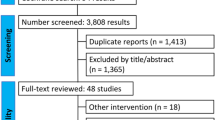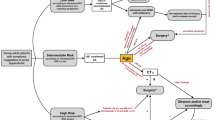Abstract
Background
Abdominal wall pain (AWP) is an important cause of chronic abdominal pain. History and physical examination are critical to the diagnosis of AWP. Trigger point injection (TPI) using either a steroid or a local anesthetic or a combination of both is often used to treat AWP.
Aim
To determine the efficacy of ultrasound-guided TPI and to determine the predictors of a successful response.
Methods
Patients who received ultrasound-guided TPI between July 2010 and June 2011 were surveyed. The primary outcome was determined using the Treatment Efficacy Questionnaire (TEQ). Electronic medical records were reviewed to determine patient, pain and TPI characteristics. Linear regression was used to determine the predictors of a successful response on the TEQ.
Results
Right upper quadrant was the most common site of AWP, and the median pain duration was 12 months. Pain was rated as >8 (1–10 scale) by 57 % and 30 % described it as an ache. Narcotic use was reported in 38 %, and 73 % had a history of at least one abdominal surgery. Forty-four of the 120 (37 %) patients met the criteria for responder on the TEQ. Compared to before treatment, 36 % reported being “significantly better” and 22 % “slightly better.” Multiple linear regression analysis showed that higher somatization negatively predicted response. None of the other historical, examination or TPI characteristics were associated with response to the TPI.
Conclusion
TPI can provide significant, long-term symptom relief in a third of patients with chronic abdominal pain attributed to AWP. Somatization was inversely related to the treatment success.

Similar content being viewed by others
References
Srinivasan R, Greenbaum DS. Chronic abdominal wall pain: a frequently overlooked problem. Practical approach to diagnosis and management. Am J Gastroenterol. 2002;97:824–830.
Costanza CD, Longstreth GF, Liu AL. Chronic abdominal wall pain: clinical features, health care costs, and long-term outcome. Clin Gastroenterol Hepatol. 2004;2:395–399.
Greenbaum DS, Greenbaum RB, Joseph JG, Natale JE. Chronic abdominal wall pain. Diagnostic validity and costs. Dig Dis Sci. 1994;39:1935–1941.
Applegate WV, Buckwalter NR. Microanatomy of the structures contributing to abdominal cutaneous nerve entrapment syndrome. J Am Board Fam Pract. 1997;10:329–332.
Suleiman S, Johnston DE. The abdominal wall: an overlooked source of pain. Am Fam Phys. 2001;64:431–438.
Anyfantakis D, Kastanakis M, Petrakis G, Bobolakis E. Rectus sheath hematoma in a single secondary care institution: a retrospective study. Hernia 2015;19:509–512
Towfigh S, Anderson S, Walker A. When it is not a spigelian hernia: abdominal cutaneous nerve entrapment syndrome. Am Surg. 2013;79:1111–1114.
Scott EM, Scott BB. Painful rib syndrome—a review of 76 cases. Gut. 1993;34:1006–1008.
Ozel L, Sagiroglu J, Unal A, et al. Abdominal wall endometriosis in the cesarean section surgical scar: a potential diagnostic pitfall. J Obstet Gynaecol Res. 2012;38:526–530.
Akhnikh S, de Korte N, de Winter P. Anterior cutaneous nerve entrapment syndrome (acnes): the forgotten diagnosis. Eur J Pediatr. 2014;173:445–449.
Drossman DA, Toner BB, Whitehead WE, et al. Cognitive-behavioral therapy versus education and desipramine versus placebo for moderate to severe functional bowel disorders. Gastroenterology. 2003;125:19–31.
Grover M, Dorn SD, Weinland SR, et al. Atypical antipsychotic quetiapine in the management of severe refractory functional gastrointestinal disorders. Dig Dis Sci. 2009;54:1284–1291.
Hershfield NB. The abdominal wall. A frequently overlooked source of abdominal pain. J Clin Gastroenterol. 1992;14:199–202.
McGarrity TJ, Peters DJ, Thompson C, McGarrity SJ. Outcome of patients with chronic abdominal pain referred to chronic pain clinic. Am J Gastroenterol. 2000;95:1812–1816.
Sharpstone D, Colin-Jones DG. Chronic, non-visceral abdominal pain. Gut. 1994;35:833–836.
Straus JL, von Ammon Cavanaugh S. Placebo effects. Issues for clinical practice in psychiatry and medicine. Psychosomatics. 1996;37:315–326.
Thomson WH, Dawes RF, Carter SS. Abdominal wall tenderness: a useful sign in chronic abdominal pain. Br J Surg. 1991;78:223–225.
Gray DW, Dixon JM, Seabrook G, Collin J. Is abdominal wall tenderness a useful sign in the diagnosis of non-specific abdominal pain? Ann R Coll Surg Engl. 1988;70:233–234.
van Assen T, Boelens OB, Kamphuis JT, Scheltinga MR, Roumen RM. Construction and validation of a questionnaire distinguishing a chronic abdominal wall pain syndrome from irritable bowel syndrome. Frontline Gastroenterol. 2012;3:288–294.
Fiala T. Tranversus abdominis plane block during abdominoplasty to improve postoperative patient comfort. Aesthet Surg J. 2014;35:72–80
Boelens OB, van Assen T, Houterman S, Scheltinga MR, Roumen RM. A double-blind, randomized, controlled trial on surgery for chronic abdominal pain due to anterior cutaneous nerve entrapment syndrome. Ann Surg. 2013;257:845–849.
Acknowledgments
The authors wish to thank Lori R. Anderson for her assistance in the preparation of the manuscript.
Conflict of interest
The authors declare that they have no conflict of interest.
Author information
Authors and Affiliations
Corresponding author
Rights and permissions
About this article
Cite this article
Alnahhas, M.F., Oxentenko, S.C., Locke, G.R. et al. Outcomes of Ultrasound-Guided Trigger Point Injection for Abdominal Wall Pain. Dig Dis Sci 61, 572–577 (2016). https://doi.org/10.1007/s10620-015-3857-8
Received:
Accepted:
Published:
Issue Date:
DOI: https://doi.org/10.1007/s10620-015-3857-8




